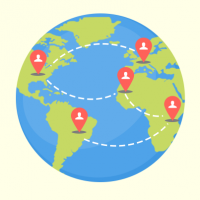For Distributed Team Success, Think Differently about When

We often think about where people work. If you have a distributed team, your main concerns may be about the impact of distance on the effectiveness of collaboration, what video communication tools to use, and how frequently (if ever) you can all meet up in person.
Collaboration is crucial in agile teams, and beyond thinking about where teams interact, it’s important to think about when, too.
With the focus on the effects of space, time often gets ignored. Activities usually get scheduled based on constraints such as availability and time zone, but people don’t often take into account when the most effective time to meet would be.
Geographically distributed teams make these challenges harder. Depending on where the teams are, you may discover that the window of time for everyone’s core working hours at each location is small. You can end up with minimal overlap time (or at least minimal overlap at a time that is mutually agreeable), and in some cases, that entire time gets taken up by group meetings, leaving little time for the peer-to-peer, small-group, and ad hoc problem-solving that helps build connections and understanding.
One approach to scheduling meetings is to “spread the misery,” varying the start times of meetings so that each location takes turns being inconvenienced. While this might address any site-equity issues, it also ignores an aspect of how people work.
In When: The Scientific Secrets of Perfect Timing, Daniel H. Pink explains how people follow patterns in terms of what times are best for heads-down work, which are best for more low-key activities, and which are best for energetic collaboration. While we can work around these natural rhythms when we need to, consistently scheduling meetings without paying attention to people’s work tendencies and preferences could mean that you are making it harder for the team to be effective. It may be worth reconsidering what it means for a geographically distributed team to collaborate—for example, working as two independent teams with well-defined interfaces (and common domain knowledge) rather than one team.
Whether your team fits in one room, spans floors in the same building, or is distributed around the globe, the more opportunities the people on the team have to connect, the more effective the team will be. Part of improving these connections is to be aware of the impact of distance and time on how people collaborate.
This isn’t an easy problem, and geography can make it a more difficult one. But the same principles apply in each situation, and the answers may conflict with your initial assumptions. What’s the best way to find out what will work for your teams? Ask. As in most agile situations, communication should be the first step.

